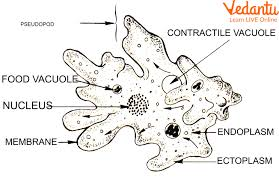How Amoeba Survives: Feeding, Movement, and Reproduction
Amoeba (amoeba pronunciation: uh-mee-buh) is a unicellular organism found mostly in water bodies such as ponds, lakes, and slow-moving rivers. Unlike plants, animals, or fungi, the amoeba belongs to the Protista group (also referred to as the amoeba kingdom in some contexts). It is well-known for its ability to change shape using finger-like projections called pseudopodia.
In certain situations, amoebas can enter the human body and lead to health problems. For example, Naegleria fowleri is sometimes called the “brain-eating amoeba,” which can be life-threatening. Thankfully, these cases are rare, but they highlight the importance of understanding amoebas and how they affect living organisms.
Below is everything you need to know about amoeba structure, amoeba classification, feeding methods, reproduction, and more.
Structure of Amoeba

Cell Membrane
Amoebas have a thin, double-layered plasma membrane. This membrane is semi-permeable, allowing certain substances to move in and out of the cell.
Cytoplasm
The cytoplasm is divided into two layers: the outer ectoplasm (clear and gel-like) and the inner endoplasm (granular and fluid-like).
The constant flow of cytoplasm helps in forming pseudopodia, which are vital for movement and capturing food.
Nucleus
Amoebas contain a prominent nucleus that regulates cell functions, including growth and reproduction.
Organelles
Amoebas have a Contractile Vacuole, which helps regulate water balance by expelling excess water.
Other organelles include Mitochondria for energy production, Golgi apparatus for packaging substances, and storage structures like fat globules.
Classification of Amoeba
Traditionally, amoebas were placed under the Protista kingdom because they do not fit the criteria of plants, animals, or fungi.
Modern classification often focuses on the organism’s genetic information and cell structure. Still, the term “amoeba classification” generally indicates they are eukaryotes, which means they have a well-defined nucleus.
Naegleria fowleri is technically not a true amoeba but an amoeboid organism. It becomes dangerous when it enters the human body, usually through the nose, and attacks the brain.
Feeding and Movement
Pseudopodia Formation: Amoeba moves by extending its cytoplasm to form pseudopodia. This process also helps in capturing food through:
Phagocytosis – The amoeba engulfs solid particles or smaller organisms.
Pinocytosis – The amoeba engulfs liquid droplets containing nutrients.
Method of Consumption: The ingested material forms a food vacuole where digestion takes place. Nutrients are absorbed, and waste material is expelled out of the cell.
Reproduction and Lifespan
Asexual Reproduction: Amoeba reproduces mainly by Binary Fission, where the nucleus divides first, followed by the division of the cytoplasm to produce two daughter cells. Each daughter cell is genetically identical to the parent.
Lifespan: A typical amoeba has an average lifespan of about two days. However, because it continuously undergoes binary fission, the lineage can be considered “immortal,” as new identical cells keep forming.
Survival Under Harsh Conditions: When the environment is unfavourable, amoebas form a spherical, protective structure called a microbial cyst. It allows them to remain dormant. When the conditions improve, they revert to the active trophozoite stage and resume feeding.
Common Symptoms of Pathogenic Amoeba
Some amoebas can be harmful if they invade the human body. Amoeba symptoms can include:
Stomach pain, cramping, and diarrhoea (often associated with Entamoeba histolytica).
Headache, fever, and neck stiffness in very rare but severe cases like Naegleria fowleri.
Fatigue and dehydration if prolonged diarrhoea occurs.
If these symptoms appear, medical advice is important for proper diagnosis and treatment.
Interesting Facts About Amoebas
Amoeba Size: Most amoebas are microscopic, typically ranging from 10 to 600 micrometres. However, some giant amoebas can be visible to the naked eye.
Amoeba Bacteria? Amoebas are not bacteria; they are single-celled eukaryotes. They are generally larger and have a nucleus, unlike bacteria which lack a true nucleus.
Rapid Shape Changes: Multiple pseudopodia can form at once, causing its shape to shift quickly.
Brain-eating Amoeba: Naegleria fowleri, often called the “brain-eating amoeba,” primarily attacks the brain tissue, leading to severe symptoms and high fatality rates if it infects humans.
Interactive Quiz (with Answers)
1. Which organelle helps amoeba remove excess water?
A. Golgi apparatus
B. Contractile vacuole
C. Nucleus
Answer: B. Contractile vacuole
2. What process does amoeba use to engulf solid food particles?
A. Pinocytosis
B. Binary Fission
C. Phagocytosis
Answer: C. Phagocytosis
3. Which layer of amoeba’s cytoplasm is clear and gel-like?
A. Endoplasm
B. Ectoplasm
C. Mesoplasm
Answer: B. Ectoplasm
4. True or False: Amoeba can survive by forming a protective cyst in harsh conditions.
Answer: True
Feel free to test your understanding with these questions and check how much you’ve learned!
Also, read Cell Structure and Function


FAQs on Amoeba: Structure, Life Functions, and Importance
1. Are amoebas immortal?
Technically, amoebas can appear immortal as they reproduce through binary fission. The original cell splits to form two new cells, continuing the lineage indefinitely.
2. Is Naegleria fowleri a true amoeba?
Naegleria fowleri is often called the brain-eating amoeba. However, it is an amoeboid organism, not a classic amoeba. It can cause severe infections if it enters the human body.
3. What is the difference between amoeba and bacteria?
Amoebas are eukaryotes with a true nucleus and organelles. Bacteria are prokaryotes without a membrane-bound nucleus. Amoebas are generally larger than bacteria as well.
4. How does amoeba affect humans?
Certain amoebas can cause diseases like amoebic dysentery or, in rare cases, severe brain infections. Symptoms often include gastrointestinal distress or neurological issues.
5. Can amoebas be seen with the naked eye?
Most amoebas are microscopic, but a few giant species can be large enough to see without a microscope.










